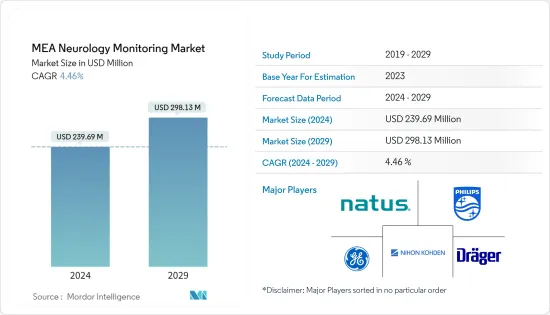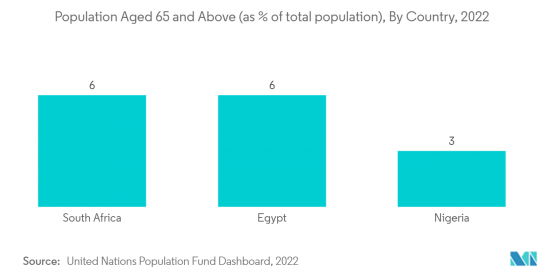PUBLISHER: Mordor Intelligence | PRODUCT CODE: 1403813

PUBLISHER: Mordor Intelligence | PRODUCT CODE: 1403813
MEA Neurology Monitoring - Market Share Analysis, Industry Trends & Statistics, Growth Forecasts 2024 - 2029

The MEA Neurology Monitoring Market size is estimated at USD 239.69 million in 2024, and is expected to reach USD 298.13 million by 2029, growing at a CAGR of 4.46% during the forecast period (2024-2029).
Key Highlights
- The COVID-19 pandemic significantly impacted neurology care in the Middle East and African regions during the initial phase, which in turn impacted the usage of neurology devices as well. For instance, according to an article published by Hindawi in August 2021, a study was conducted in Abu Dhabi, UAE, which showed that the patients infected with COVID-19 often presented with neurological manifestations in the form of headache, dizziness, hyposmia, myalgia, peripheral neuropathy, acute cerebrovascular disease, and encephalopathy.
- The source also stated that neurological involvement could be due to virus-induced brain hypoxia, brain infection, or immune reaction. Thus, the COVID-19 pandemic significantly impacted the market initially; however, as the pandemic has currently subsided, neurology care is going back to normal in the region. Hence, the studied market is expected to have stable growth during the forecast period of the study.
- The key factors propelling the growth of the studied market are the increasing burden of neurological disorders, the growing incidence of traumatic brain injuries, and the rising geriatric population in the country.
- The increasing incidence of neurological disorders like brain aneurysms, brain tumors, epilepsy, memory disorders, multiple sclerosis, Parkinson's disease, peripheral neuropathy, post-herpetic neuralgia, spinal cord tumors, and stroke is the major factor driving the market growth.
- For instance, according to an article published by MDPI in June 2022, a study was conducted in UAE that stated that a brain aneurysm is a critical condition that mostly affects young adults and may cause life-threatening complications such as brain hemorrhage. Furthermore, patients with untreated unruptured aneurysms have 50% excess long-term mortality compared with the general population. Thus, the high burden of diseases such as brain aneurysms is expected to boost the market growth.
- Furthermore, according to an article published by PubMed in September 2022, it is estimated that the incidence of traumatic brain injury (TBI) in Saudi Arabia is 116 per 1,00,000 population, and it is also expected to rise in the region. The source also stated that a study was conducted which showed that road traffic accident was the most common mechanism of injury (49.7%) for traumatic brain injuries, followed by fall (39.5%). Thus, the high prevalence of traumatic brain injuries is expected to enhance the usage of neurological monitoring devices. Moreover, as these neurological diseases mostly occur in the elderly population, the rising geriatric population in the country is also expected to enhance market growth.
- Thus, the aforementioned factors, such as the rising prevalence of neurological disorders and the increasing incidence of traumatic brain injuries, are expected to boost the market growth during the forecast period of the study. However, the high cost of devices and the shortage of trained professionals are expected to impede market growth.
MEA Neurology Monitoring Market Trends
Electroencephalography (EEG) Devices Segment is Expected to Grow with a Significant CAGR Over the Forecast Period
- Electroencephalography (EEG) is an electrophysiological monitoring method that is used to record the electrical activity of the brain. It is used to measure and record brain wave activity for the diagnosis and treatment of sleep apnea. Due to this increased use and demand for high-quality EEG devices, there are now numerous companies that can cater to the specific needs of EEG users. The rising prevalence of diseases such as brain cancer and Alzheimer's disease, among others, is the major factor driving the segment growth.
- For instance, according to the article published by Alzheimer's & Dementia Journal in September 2021, the prevalence of dementia is increasing across the African continent at the same time as the aging population in low- and middle-income nations. The source also stated that in areas of rapidly changing Africa, dementia prevalence ranges from 2.3% to 20.0%, and incidence rates are 13.3 per 1000 person-years with rising mortality. Thus, the high burden of the disease in the region is expected to increase the demand for EEG devices, which will likely propel the segment growth over the study period.
- Moreover, according to the study report published by Research Square in May 2022, a study was conducted that showed that the highest estimate of those living with dementia above the age of 50 and 60 was in Egypt, Algeria, and Morocco. This high burden of disease in these countries is expected to increase the demand for EEG devices.
- Thus, the aforementioned factors, such as the rising prevalence of various neurological disorders coupled with the rising geriatric population, are expected to boost the segment growth.

GCC is Expected to Hold a Significant Market Share Over the Forecast Period
- The GCC region comprises Bahrain, Kuwait, Oman, Qatar, Saudi Arabia, and the United Arab Emirates. The major factors driving the growth of the market in GCC are the increasing prevalence of neurological disorders, the increasing launch of technologically advanced products, the rising geriatric population, and the growing traumatic brain injuries in the region.
- According to a study released by the Lancet Public Health in January 2022, the UAE and other Gulf countries are predicted to report the highest increases in the number of people living with dementia over the next 30 years worldwide. It was estimated that the UAE will see an increase of 1,795% in people suffering from dementia by 2050, and neighboring Gulf countries, such as Qatar and Bahrain, will see an increase in dementia cases of 1,926% and 1,084% by 2050, respectively. Thus, the high number of dementia cases is expected to increase the prevalence of Alzheimer's disease in the region over the forecast period, thereby propelling the adoption of neurology monitoring devices.
- Moreover, according to an article published by Cureus in December 2021, traumatic brain injury (TBI) can be caused by interference with the normal function of the brain that can be caused by any force to the head. The source also stated that a study was conducted in Riyadh, Saudi Arabia, which showed that the majority of traumatic brain injuries were caused by motor vehicle collisions and pedestrian injuries in the country. Moreover, the rising geriatric population in the region is also a major factor driving the market growth, as neurological disorders are mainly found in elderly people.
- Thus, the aforementioned factors, such as the rising prevalence of neurological disorders and the increasing incidence of traumatic brain injuries, are expected to boost the market growth during the forecast period of the study.
MEA Neurology Monitoring Industry Overview
The Middle East and Africa neurology monitoring market is moderately competitive with several major players. Some of the strategies implemented include agreements, collaborative models, business expansion, and product development. Some of the key players operating in the market are Natus Medical, Inc., Nihon Kohden Corporation, Dragerwerk Ag & Co. Kgaa, and GE Healthcare, among others.
Additional Benefits:
- The market estimate (ME) sheet in Excel format
- 3 months of analyst support
TABLE OF CONTENTS
1 INTRODUCTION
- 1.1 Study Assumptions and Market Definition
- 1.2 Scope of the Study
2 RESEARCH METHODOLOGY
3 EXECUTIVE SUMMARY
4 MARKET DYNAMICS
- 4.1 Market Overview
- 4.2 Market Drivers
- 4.2.1 Increasing Burden of Neurological Disorders
- 4.2.2 Growing Incidence of Traumatic Brain Injuries
- 4.3 Market Restraints
- 4.3.1 High Cost of Devices and Shortage of Trained Professionals
- 4.4 Porter's Five Forces Analysis
- 4.4.1 Threat of New Entrants
- 4.4.2 Bargaining Power of Buyers/Consumers
- 4.4.3 Bargaining Power of Suppliers
- 4.4.4 Threat of Substitute Products
- 4.4.5 Intensity of Competitive Rivalry
5 MARKET SEGMENTATION (Market Size by Value - USD)
- 5.1 By Product Type
- 5.1.1 Magnetic Resonance Imaging (MRI) Devices
- 5.1.2 Electroencephalography Devices
- 5.1.3 Cerebral Oximeters
- 5.1.4 Intracranial Pressure Monitors
- 5.1.5 Other Product Types
- 5.2 By Disease Type
- 5.2.1 Traumatic Brain Injury (TBI)
- 5.2.2 Stroke
- 5.2.3 Sleep Disorders
- 5.2.4 Parkinson's Disease
- 5.2.5 Epilepsy
- 5.2.6 Other Diesease Types
- 5.3 Geography
- 5.3.1 GCC
- 5.3.2 South Africa
- 5.3.3 Rest of Middle East & Africa
6 COMPETITIVE LANDSCAPE
- 6.1 Company Profiles
- 6.1.1 Natus Medical, Inc.
- 6.1.2 Nihon Kohden Corporation
- 6.1.3 Koninklijke Philips N.V.
- 6.1.4 Dragerwerk Ag & Co. Kgaa
- 6.1.5 GE Healthcare
- 6.1.6 Siemens Healthineers
- 6.1.7 Masimo Corporation
- 6.1.8 Medtronic Plc
7 MARKET OPPORTUNITIES AND FUTURE TRENDS




